Part One: What IS A Liberty XL-2?
 I've been looking forward to this one… the
first chance to get a hold of an aircraft that appears poised to
take on the legacy left SO-o-o-o-o-o long ago by the Cessna 152,
Piper "Trauma"hawk, Beech Skipper, Grumman Yankee/TR-2 and a few
rarely remembered has-beens.
I've been looking forward to this one… the
first chance to get a hold of an aircraft that appears poised to
take on the legacy left SO-o-o-o-o-o long ago by the Cessna 152,
Piper "Trauma"hawk, Beech Skipper, Grumman Yankee/TR-2 and a few
rarely remembered has-beens.
While the industry's doldrums have relented sufficiently enough
to see a number of new and oft innovative four place designs come
to the market, there has been a dearth of two seaters that can
serve both the airplane-starved training market as well as a
burgeoning entry-level aircraft ownership market that I truly
believe is far larger than many think.
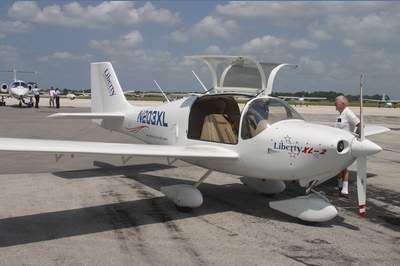
While the CH-2000, the Diamond Katana, and the OMF Symphony are,
indeed, out and about, the market has needed a solid shot in the
arm… a little more modern technology (unlike the
ultra-conservative CH-2000) and a serious production chain (unlike
the Symphony, which may be stopped in its tracks due to the
ever-present specter of a legal shutdown -- at least here in the
USA). Only the Diamond Katana, especially the Continental-powered
C1 rocketship (a heckuva nice bird), seems competitive under the
circumstances.
But: the Liberty XL-2 could be the deal-breaker… THE bird
that breaks through to a nearly stagnant part of the GA market and
excites a significant number of people enough to depart from
their occasional aircraft rentals and become real-live aircraft
owners.
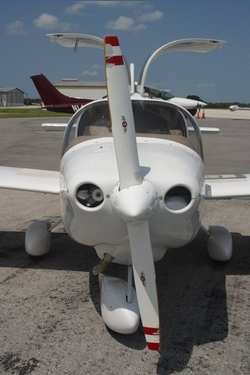 It offers some significant inducement: outstanding
styling, a serious upgrade in technology, an overt effort to make
the bird economical to operate, and more performance than the birds
in this genre generally offer. Looking, first, like an offshoot of
Ivan Shaw's highly regarded Europa trike-gear, the XL-2 is actually
a significant redesign of a planform that kept the best aspects of
the Europa's aerodynamics (with some inspired tweaking by Shaw and
aerodynamicist Don Dykins) but adapted it to a 21st Century
airframe that is designed to be durable, buildable and
economical.
It offers some significant inducement: outstanding
styling, a serious upgrade in technology, an overt effort to make
the bird economical to operate, and more performance than the birds
in this genre generally offer. Looking, first, like an offshoot of
Ivan Shaw's highly regarded Europa trike-gear, the XL-2 is actually
a significant redesign of a planform that kept the best aspects of
the Europa's aerodynamics (with some inspired tweaking by Shaw and
aerodynamicist Don Dykins) but adapted it to a 21st Century
airframe that is designed to be durable, buildable and
economical.
A Whole New Approach
The $116,500 (base price) VFR/IFR day/night bird mixes a number
of technologies -- each according to what suits itself to the
mission at hand. The fuselage is a tough high-tech carbon
fibre shell wrapped around a rugged steel-tube substructure; the
main landing gear is aluminum; the wing/horizontal tail is
simple/conventional metal; the 125 HP Continental engine is
FADEC-equipped; and the 48-inch wide cockpit was actually designed
to fit real-life-sized adults (rather than the midgets GA has been
building planes for, lo these many years).
One of the more laudable features of the XL-2 is the decision to
go with a FADEC system for the installed powerplant. This is the
first serious implementation of such a system on a mainstream GA
serial production aircraft. Teledyne Continental IOF-240-B's
Powerlink FADEC (Fully Automated Digital Engine Controls) engine
control system offers computer controlled electronic ignition, a
sequential direct port fuel injection system, a devilishly simple
single lever throttle, computerized cylinder control, a maintenance
data port (from which you can download and track engine histories
and perform diagnostics), induction air filter and a full flow oil
filter.
One keeps track of the health of the powerplant via a Vision
Microsystems VM-1000 mounted on the bottom center of the panel on
the left side of the cockpit (though it is quite visible and
readable from the right), that offers both graphic as well as
analog readouts, 'Autotrack' Mode (which lets you know when the
engine changes its mind about a certain parameter), 'Diamond
Graph,' Tachometer, Percentage/Power Readout, EGT, CHT, Volts,
Amps, MP, Fuel Pressure, Oil Pressure, and Oil Temp.
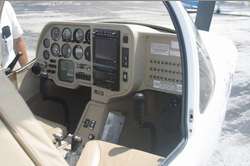
The whole works is fed by a single integrated 28 gallon fuel
tank in the fuselage. Supporting fuel systems include a quick drain
fuel valve, engine driven fuel pump, an additional electric fuel
pump-boost, the obligatory fuel gauge (electric) and a fuel shutoff
valve.
The XL-2 uses a 14 volt electrical system, with dual Condorde
lead-acid batteries (each chain of the FADEC has its own), a
dedicated Avionics Master Switch (to augment the standard master
switch), a 60 amp alternator (with warning annunciator), and a
series of pull-type (trip-free) breakers on the far right hand side
of the panel. An external 14v APU plug is standard. The standard
cockpit comes with conventional basic instruments and the panel
design is one of the few things slightly reminiscent of the
Europa… with the prominent protruding radio stack in the
center and the diminished reliance on the right side as a nesting
place for instrumentation and avionics (instead being the home of
the circuit breakers and such-though a glove box or chart-holder
might be welcome here, to boot). The overall effect is expansive,
well organized, and reasonably accessible from either seat.
Currently, Liberty offers either Garmin or UPS avionics…
though the bird I flew had a UPS stack that included the luscious
MX-20… one of the nicest MFD systems currently available
(and a box that really makes getting around complicated airspace a
singular pleasure). There is good visibility over the top of the
panel and the side-slope offers adequate peripheral vision for most
operations without having to go into "giraffe mode."
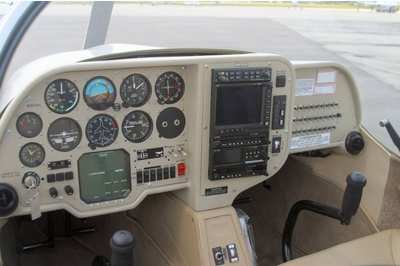
I was particularly pleased with the large and well placed
adjustable cabin vents (which abut each side of the cockpit just
underneath the bottom ledge of the panel)… since the XL-2
boasts lots of gorgeous glass, its sure to heat up when the Sun is
doing its thing. Cabin heating is standard, as is a windshield
defroster, stereo headset plugs, and some good sized map/storage
pockets attached to each seat.
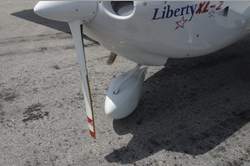 The center console between the seats hosts some
unconventional features… at least one of them destined to be
somewhat controversial. The ground steering is not
accomplished via toe brakes (though an option will allow that for
those who insist on it). Instead, the free-castering nose wheel is
directed via two small finger-operated levers next to the throttle
(which actuate Cleveland wheels and brakes). Slight pressure
deploys the brakes, either together or differentially. It's
going to tick off a few folks, but I found the system (not the
first of its kind that I'd seen) to be easy to operate, deft at
directing the plane on the ground, and overtly pleasant to work
with -- though I just know that a few folks are going to hate
it and opt for the normal (and available) state of affairs. A
parking brake is part of the two-lever system and I appreciated its
lack of complication: A small lever (between the brakes) is pulled
up as you pull back to "lock" both brake levers, and the
stopping power was sufficient to hold us during an aggressive
run-up. Releasing it is a simple push/release on the lock,
downwards, and off you go.
The center console between the seats hosts some
unconventional features… at least one of them destined to be
somewhat controversial. The ground steering is not
accomplished via toe brakes (though an option will allow that for
those who insist on it). Instead, the free-castering nose wheel is
directed via two small finger-operated levers next to the throttle
(which actuate Cleveland wheels and brakes). Slight pressure
deploys the brakes, either together or differentially. It's
going to tick off a few folks, but I found the system (not the
first of its kind that I'd seen) to be easy to operate, deft at
directing the plane on the ground, and overtly pleasant to work
with -- though I just know that a few folks are going to hate
it and opt for the normal (and available) state of affairs. A
parking brake is part of the two-lever system and I appreciated its
lack of complication: A small lever (between the brakes) is pulled
up as you pull back to "lock" both brake levers, and the
stopping power was sufficient to hold us during an aggressive
run-up. Releasing it is a simple push/release on the lock,
downwards, and off you go.
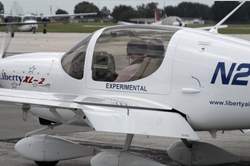 The throttle is a single control… there is
no mixture -- that's a function of the FADEC. On the bird we flew,
the throttle was pretty sticky to operate and one of the casualties
of the constant R&D process, but its positioning is awfully
convenient and the ergonomics are "right on."
The throttle is a single control… there is
no mixture -- that's a function of the FADEC. On the bird we flew,
the throttle was pretty sticky to operate and one of the casualties
of the constant R&D process, but its positioning is awfully
convenient and the ergonomics are "right on."
Close by lies the electric pitch trim, augmented by a
panel-mounted gauge that measures deployment (a bit sensitive on
the prototype and promised to be detuned well before production
birds roll off the line). Forward on the center panel, on the
inclined section between the console and the instrument panel is
the flap lever and a small gauge that mirrors flap position…
though I far prefer looking out over the wing and simply checking
it directly (where the Liberty gang has put two taped strips to
denote the 15 and 40 degree setting-I hope they do that with
production birds).
 Overall, the airframe presents a pleasant roomy
feel with an obvious effort toward workable ergonomics that
produces a cockpit that is a pleasure to work and play in…
and an obvious departure from the Marquis de Sade school of cabin
design that was typical of most GA designs for way too long. I
liked it… it didn't feel like an entry-level basic airplane,
but one that that should have been typical of a more
expensive airplane… and this was a trend that was to
continue as the ground inspection gave way to the actual
flying.
Overall, the airframe presents a pleasant roomy
feel with an obvious effort toward workable ergonomics that
produces a cockpit that is a pleasure to work and play in…
and an obvious departure from the Marquis de Sade school of cabin
design that was typical of most GA designs for way too long. I
liked it… it didn't feel like an entry-level basic airplane,
but one that that should have been typical of a more
expensive airplane… and this was a trend that was to
continue as the ground inspection gave way to the actual
flying.
Tomorrow:
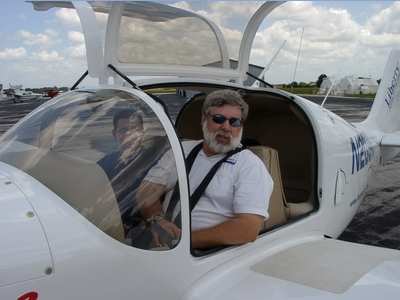
Getting Ready For the Flight Test
 First, some caveats: this is the much loved but
nonetheless abused production prototype; it is a bird that has been
ridden hard and put up wet… more than once. It is
not a pampered and primped bird meant to be presented to
the wimpy media as a best-case scenario. It is a battered
and slightly bruised workhorse/test-bed that is already showing
some wear and tear and has been used to try out a number of
modifications (which have not always worked -- which is the way
these things are supposed to go). Under normal circumstances, this
is the LAST bird you show the media… but regardless of that,
Liberty Aerospace gave me carte blanche to go beat the little
critter to death… and I did (but knowing me, they probably
didn't want to risk a perfectly good airplane with yours
truly).
First, some caveats: this is the much loved but
nonetheless abused production prototype; it is a bird that has been
ridden hard and put up wet… more than once. It is
not a pampered and primped bird meant to be presented to
the wimpy media as a best-case scenario. It is a battered
and slightly bruised workhorse/test-bed that is already showing
some wear and tear and has been used to try out a number of
modifications (which have not always worked -- which is the way
these things are supposed to go). Under normal circumstances, this
is the LAST bird you show the media… but regardless of that,
Liberty Aerospace gave me carte blanche to go beat the little
critter to death… and I did (but knowing me, they probably
didn't want to risk a perfectly good airplane with yours
truly).
It was definitely an acid test: the temp was above 90 degrees,
the DA was a little higher than we normally get at near sea-level
Winter Haven, the load was right at the max gross (especially on my
side of the aircraft--and this was BEFORE lunch, thank God), and
the prop's paint had been chewed up in a recent rainstorm so badly
it had to be cavitating like a Waring blender. I wasn't
expecting a whole lot from it under the circumstances and
expected to have to give the airplane the "benefit of the doubt"
during the flight test. I was wrong.
Space, The Final Frontier…
 The current prototype is not yet equipped with a
step, so the preferred entry method is to walk to the leading edge
of the wing, turn around, sit back and slide back on the wing and
up onto the door ledge and into the cockpit. Not as cumbersome as
it sounds, this is a temporary move that will serve until steps are
installed. Once inside, one notices something really unusual in a
two seater: space. Lots of it. There is shoulder room, leg room
(especially with the adjustable rudder pedals), head room, you name
it… and just behind the two seats is a BIG baggage
compartment (4ft x 3ft x 2ft) that will easily take more baggage
than one should reasonably load (please note… space is one
thing, payload is another… be sure you know what your
baggage weighs before throwing it aboard -- and the limit in the
XL-2 is 100 pounds).
The current prototype is not yet equipped with a
step, so the preferred entry method is to walk to the leading edge
of the wing, turn around, sit back and slide back on the wing and
up onto the door ledge and into the cockpit. Not as cumbersome as
it sounds, this is a temporary move that will serve until steps are
installed. Once inside, one notices something really unusual in a
two seater: space. Lots of it. There is shoulder room, leg room
(especially with the adjustable rudder pedals), head room, you name
it… and just behind the two seats is a BIG baggage
compartment (4ft x 3ft x 2ft) that will easily take more baggage
than one should reasonably load (please note… space is one
thing, payload is another… be sure you know what your
baggage weighs before throwing it aboard -- and the limit in the
XL-2 is 100 pounds).
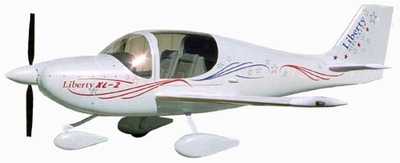
Adjustable pedals and comfy seats, four point belts and the
roomy confines making settling in for the flight a pretty secure
and easy affair -- especially for those of us who are "dietetically
enhanced." The clamshell doors swing way up and out of the way so
that they are of little consequence until time comes to shut
them. The XL-2 offers dual controls… that are actually
not quite dual. Each stick is one half of a U-shaped affair that
connects in the center of the fuselage, underneath the center
tunnel that separates the seats. The effect is agile and not nearly
as disruptive as similar implementations I have seen on other
designs trying for the same simplicity of control circuitry.
This one works.
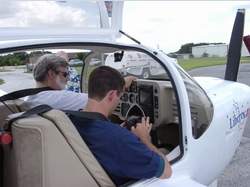 Startup is no big deal… turn on the master,
ready the appropriate support systems (lights, pumps, avionics,
your favorite boogy-woogy music, etc), flip on the dual FADEC
systems, and turn the key to get the little IOF-240 rumbling to
life.
Startup is no big deal… turn on the master,
ready the appropriate support systems (lights, pumps, avionics,
your favorite boogy-woogy music, etc), flip on the dual FADEC
systems, and turn the key to get the little IOF-240 rumbling to
life.
With the housekeeping out of the way, it was time to make our
way to Winter Haven's Runway 4 for the good part of this job. A
little throttle got us rolling and some tweaking on the brake
levers kept us on the straight and narrow… while I am
generally one for "creative" taxiing (i.e., wallowing around like a
drunken sailor), I played with some adherence to the centerline and
found the system to be easy to precisely direct. Braking action is
good, taxi visibility is very good and the ride is fairly
comfy… even with some of Winter Haven's well-known pavement
irregularities to make things interesting.
Run-up is conventional: lock the brakes, set the revs and simply
add a check of either FADEC chain to the list before you head for
the wild blue. The Vision Micro System gauge's placement makes for
easy diagnostics and offers little guess-work when it comes time to
make the decision to aviate.
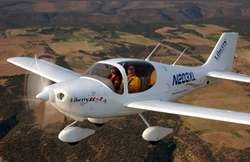
I elected a no-flap takeoff for the first go. We had a light
quartering crosswind of less than 6 knots, and after centering the
nosewheel, I advanced power swiftly, pleased with the IOF-240's
excellent linear response to throttle input right from the get-go.
The rudder on the XL-2 is no wimp… even as we barely got
rolling, it was obvious that we were done with the brakes. A tap on
the pedal centered things very obediently and the Liberty tracked
the center line like a slot car heading for the finish line.
With excellent coaching from Liberty's Jason "Ace" Livingston,
the new Liberty demo pilot, (who is going to learn the true
definition of fear over the next few weeks--nothing I have ever
done is as weird and potentially hazardous as shepherding pilots of
all kinds through the rudiments of a demo ride…), I
lightened the nose wheel with a half pound or so of aft stick
pressure (the aircraft pre-trimmed for conventional take-off
norms), at about 40, increased the pressure slightly about 55-60
knots and started flying just a hair short of 1000 feet down the
runway. The no-flap takeoff attitude is fairly flat… only a
few degrees pitch positive but the bird accelerated well to 70-75,
gave me a solid 550-700 feet per minute and immediately showed its
John Wayne nature with aggressive corrective response to the
building thermals as we proceeded over the wilds of Winter Haven
for the dreaded Captain Zoom Torture Test
(i.e., which happens every time I fly… It ain't pretty, I
admit it. KIDS, don't try this at home).
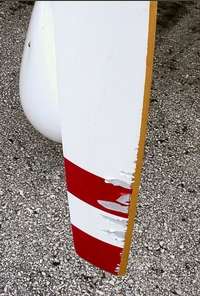 The initial climb to 2000 AGL took about three
minutes and I noted a pretty significant bit of low amplitude
vibration from the much-abused prop, which was obviously not up to
doing its thing too well -- though it didn't seem to hurting the
aircraft's overall performance one whit. Climb visibility was
fairly good in all but steep/best angle configs where the panel
finally got in the way, and cruise visibility is just plain
panoramic…all that glass is put to good use…
especially peripherally…it's like flying in a goldfish bowl
and is a thoroughly enjoyable pursuit, at that.
The initial climb to 2000 AGL took about three
minutes and I noted a pretty significant bit of low amplitude
vibration from the much-abused prop, which was obviously not up to
doing its thing too well -- though it didn't seem to hurting the
aircraft's overall performance one whit. Climb visibility was
fairly good in all but steep/best angle configs where the panel
finally got in the way, and cruise visibility is just plain
panoramic…all that glass is put to good use…
especially peripherally…it's like flying in a goldfish bowl
and is a thoroughly enjoyable pursuit, at that.
Set up for cruise, (about 100-110 kts IAS), I noted a modest
amount of aerodynamic feedback inherent in a control system that
had already distinguished itself with a lack of mechanical friction
and little in the way of mechanical breakaway inhibition. The stick
offers a slightly wider than normal range of movement in both pitch
and roll as well as an appreciable mechanical advantage for the
pilot… which translates to a system that is slightly to
moderately-pressured, even at high speed, and promotes an
unwillingness to act overtly sensitive or over-control the
critter.
Steady as She Goes!
Stability and control investigations were immediately
impressive. Overall, the XL-2 is highly responsive, as required,
but the control system boasts a high degree of linearity on cruise
control responses and equally linear force requirements. Since
there is a wide range of control in the stick, light inputs are not
radically responsive… but if you get persuasive, this thing
can rock and uh, well, ROLL. Yeah, baby!
Pitch stability is tightly defined. Properly configured, a
cruising XL-2's static stability also takes on slot-car like
adherence to the trimmed attitude. Numerous excitations from the
trimmed configuration of some 10-20 degrees (3 degree per second
onset and stick-free), produced one, occasionally two, excursions
before getting back to business. In most cases, the oscillation (a
poor term for what really occurs) is practically deadbeat with but
a single wimpy "girly-man" cycle. The cycle was highly convergent
and of low frequency. A few quick attempts to excite some
aero-uglies in the short-period pitch profile produced a highly
convergent response that was also about as deadbeat as it gets --
especially in a light piston bird.
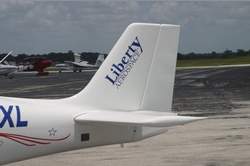
Roll/yaw harmonize really nicely… especially for those of
us who feel the need to play "12 O'Clock High" every now and then
(OK… all the time). Yanking and banking with the XL-2 can be
a lot of fun… but is also a most obedient pursuit. The
rudder is modestly separated (just about right, I think, for this
genre of light aircraft) and also banks the aircraft well with
anything more than a modest tap on the pedal. The roll axis offers
light to modest adverse yaw and coordinates well with the rudder to
produce an excellent roll rate… especially with significant
input. With steady-heading side-slip investigations and such, the
XL-2 proved itself fairly positive and directionally persuasive in
both roll and yaw. Control pressures vary from light to moderate,
are nearly as linear as pitch, and blend to produce a pretty nice
combo of obedience and stability.
Slowed down, control pressures lighten up perceptibly but
modestly. I noted some 20-25% diminution of control force feedback
over the cruise to slow-flight transition and less diminution in
overall control response. Stability investigations were somewhat
less positively defined (in terms of dynamic response... but the
static margins still were still impressively accurate), but still
far more positive than other birds this light and in this
performance profile. All in all, a pretty nice mix.
I Feel the Need… The Need for Speed
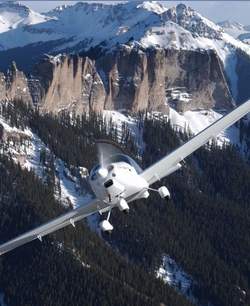 OK… I can hear you all now… "Screw
all the funky stuff, Zoomer, just how fast is this
critter?"
OK… I can hear you all now… "Screw
all the funky stuff, Zoomer, just how fast is this
critter?"
Well, OK, I'll tell ya.
Even with the paint still peeling off the prop (a horrible thing
to do to what was obviously a nicely matched Sensenich), a few runs
were made at 2000-2500 MSL with GPS coordination on a few
reciprocal runs. With the FADEC popping along at 65-70%, the
Liberty bird offered a solid 114-116 knots… far better than
I had a reason to expect. Full tilt boogy, with everything mashed
to the firewall, and all 125 ponies beat into a furious FADEC
frenzy, the XL-2 offered up well over 120 knots… with
121-123 being the mean. Mind you, that's with the prop doing the
strip tease, a full gross load, and playing down in the weeds,
instead of up high where this thing is really meant to shine.
Liberty says it will do 132 knots at max cruise, and at a more
efficient altitude (I think they're using 8000 feet for
that…) and I feel quite strongly that they'll meet or exceed
those numbers… especially with the way that Continental is
reportedly starting to dial in that FADEC…
Whoa! Liberty!
When last we left ANN Editor-In-Chief Jim Campbell, he was just
finishing up the weapons systems testing of the Liberty XL-2 by
pickling off a few "Saddam Surprises" during a short run over
downtown Baghdad… or not.
OK, he was really over Central Florida
and the bomb racks were empty… but he was going pretty fast
and getting ready to see what happened when the XL-2 finally slowed
down…
As previously noted, the XL-2 is equipped with electric flaps.
However; before I deployed them a few runs at 55-60 knots and then
to the onset of a stall buffet showed off good response, a
lightening in overall control pressure that was accompanied by
a milder diminishment in overall control authority.
Particularly positive was the rudder response up to and through the
initial buffets and recoveries… with a surprising amount of
roll authority still at my beck and call.
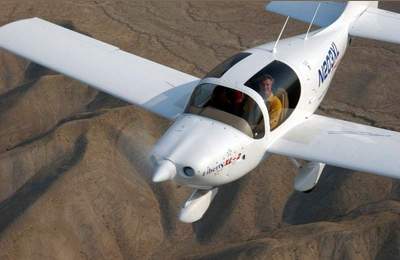
making sure things were down to about 80 knots (which requires
retardation of the throttle and a pretty pitch positive attitude),
I offered up 15 degrees of flaps (associated with the preferred
take-off setting) and noted a significant negative pitch trim
excursion that required a few pounds of aft stick pressure to
correct until I could re-trim the bird. Immediately; I noted a
significant change in personality. While the no-flap XL-2 is a
speedy (even slightly "slippery") little devil with some
speed-demons at its heart, the "first notch" of flaps on this thing
produces an even milder mannered personality that still boasts
excellent authority and stability (especially in pitch) but the
enhanced drag profile makes it far easier to keep things in the
70-80 knot range… which the slipperier no-flap bird zooms
through with abandon. Maneuvering in this configuration is docile,
a bit more rudder-dominated (and attended by more significant
adverse yaw in the roll axis) and very pleasant. Speed degradation
in this draggier configuration is not that big a deal since the
bird offers excellent physical and aural clues when it approaches
the critical angle of attack. A stall is not going to catch you by
surprise unless you're doing a Helen Keller impersonation.
Initial attempts at a full stall were met with little success in
that the bird offers a prominent high frequency, low amplitude
buffet that increases with severity (with increasing alpha) but we
simply ran out of pitch authority before we ran out of lift…
even with a 2-3 degree per second pitching onset. Flat out, we
simply couldn't coax a real-live break out of it with only 15
degrees of flaps.
Hanging It ALL Out…
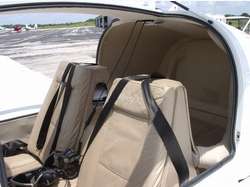 Full flaps (about 40 degrees) presented an
interesting configuration. It didn't feel like a lot more drag, the
trim change was milder than with the first 15, and the overall
effect on the bird, outside of a more negatively trimmed attitude,
was pretty much a non-event. Proceeding to a stall was just as
"shaky" an affair with a slightly more pronounced buffet of
modestly higher frequency and slightly more adverse yaw. We
got some mild buffets out of it with mild pitching onsets but a
more aggressive pitching sequence (in excess of 5 degrees per
second and with a slightly accelerated "load"), finally got the
Liberty XL-2 to do something that wasn't boring us silly. With
significant inducement, we got a good solid break that favored the
increased weight on the left side of the aircraft and a pitch down
of some 40-50 degrees. The aircraft rolled off to the left quickly
for some 20-30 degrees and then just quit as the aircraft
immediately reasserted itself into a flying configuration. No
corrective rudder was needed (and indeed the roll-off was just
that) and no yawing through the break was noted. Each axis was
immediately response and a few quick boots (either way) on the
rudder showed that it was VERY much alive and well throughout the
process but not willing to do anything obnoxious, either. I kinda
surprised Jay Livingston a mite since I had a feeling no one had
abused the XL-2 like that but the recovery was swift, thoroughly
controllable, and utterly conventional. Altitude loss was in the
range of 150 feet. Hmm… if that's as bad as it gets, that's
gonna be just fine with me (you should see what kind of nasties you
can get out of a ho-hum Cessna 152 with similar
inducement…).
Full flaps (about 40 degrees) presented an
interesting configuration. It didn't feel like a lot more drag, the
trim change was milder than with the first 15, and the overall
effect on the bird, outside of a more negatively trimmed attitude,
was pretty much a non-event. Proceeding to a stall was just as
"shaky" an affair with a slightly more pronounced buffet of
modestly higher frequency and slightly more adverse yaw. We
got some mild buffets out of it with mild pitching onsets but a
more aggressive pitching sequence (in excess of 5 degrees per
second and with a slightly accelerated "load"), finally got the
Liberty XL-2 to do something that wasn't boring us silly. With
significant inducement, we got a good solid break that favored the
increased weight on the left side of the aircraft and a pitch down
of some 40-50 degrees. The aircraft rolled off to the left quickly
for some 20-30 degrees and then just quit as the aircraft
immediately reasserted itself into a flying configuration. No
corrective rudder was needed (and indeed the roll-off was just
that) and no yawing through the break was noted. Each axis was
immediately response and a few quick boots (either way) on the
rudder showed that it was VERY much alive and well throughout the
process but not willing to do anything obnoxious, either. I kinda
surprised Jay Livingston a mite since I had a feeling no one had
abused the XL-2 like that but the recovery was swift, thoroughly
controllable, and utterly conventional. Altitude loss was in the
range of 150 feet. Hmm… if that's as bad as it gets, that's
gonna be just fine with me (you should see what kind of nasties you
can get out of a ho-hum Cessna 152 with similar
inducement…).
Heading for the Home-Drome
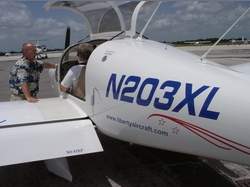 With the slow stuff out of the way it was time to
reacquaint ourselves with Terra Firma. Heading back to Winter
Haven, we slowed up in the pattern to 90 knots, and then 80 knots,
as we turned base, with 15 degrees of flaps adding nicely to the
speed management chores. The day was getting kinda bumpy, but the
XL-2 rode the uglies nicely with a minimum of Dutch roll and other
displacements. Jason did a great job of briefing me on what
was required from there on, so I used a slight slip to get rid of
some extra altitude, and still keeping us on the high side of the
slope; I dropped the rest of the flaps and was rewarded with 65-70
knots and a great descent attitude that offered equally great viz.
No additional power was necessary to make the field as the
efficient little XL-2 kept flying and held onto altitude
pretty tightly. A light crosswind was child's play with a slight
bank to counter the drift), and a roundout about 2 feet in the air
(with a modest tendency toward floating) turned out to be just a
tad late as I touched down a smidgeon over 60 kts (a little too
fast). The resulting skip damped out quickly, the rudder remained
very active and kept us pointed exactly down the centerline (a
sight I'm not all that used to, I admit). Light braking produced
good deceleration, but I missed the first turn-off and turned in a
1500 foot landing that could have been a heck of a lot shorter.
With the slow stuff out of the way it was time to
reacquaint ourselves with Terra Firma. Heading back to Winter
Haven, we slowed up in the pattern to 90 knots, and then 80 knots,
as we turned base, with 15 degrees of flaps adding nicely to the
speed management chores. The day was getting kinda bumpy, but the
XL-2 rode the uglies nicely with a minimum of Dutch roll and other
displacements. Jason did a great job of briefing me on what
was required from there on, so I used a slight slip to get rid of
some extra altitude, and still keeping us on the high side of the
slope; I dropped the rest of the flaps and was rewarded with 65-70
knots and a great descent attitude that offered equally great viz.
No additional power was necessary to make the field as the
efficient little XL-2 kept flying and held onto altitude
pretty tightly. A light crosswind was child's play with a slight
bank to counter the drift), and a roundout about 2 feet in the air
(with a modest tendency toward floating) turned out to be just a
tad late as I touched down a smidgeon over 60 kts (a little too
fast). The resulting skip damped out quickly, the rudder remained
very active and kept us pointed exactly down the centerline (a
sight I'm not all that used to, I admit). Light braking produced
good deceleration, but I missed the first turn-off and turned in a
1500 foot landing that could have been a heck of a lot shorter.
 Heading back for another try, I elected to use 15 degrees of
flaps for this departure and was rewarded with a really nice change
in that the aircraft rotated a lot more readily at 50 knots, lifted
off about 55 kts (and well under 700 feet down the way) and climbed
rather well at 65 kts for a bit, until I elected a 70 kt attitude
and settled into a 700 fpm climb. The whole personality is a good
bit more "uplifting" with a little flap, and I heartily recommend
this procedure for all but the longest runways. A quicker trip
around the patch resulted in an already familiar and comfortable
profile that I kept on the high side in order to play with the slip
a bit more… an area in which the XL-2 excels nicely.
Heading back for another try, I elected to use 15 degrees of
flaps for this departure and was rewarded with a really nice change
in that the aircraft rotated a lot more readily at 50 knots, lifted
off about 55 kts (and well under 700 feet down the way) and climbed
rather well at 65 kts for a bit, until I elected a 70 kt attitude
and settled into a 700 fpm climb. The whole personality is a good
bit more "uplifting" with a little flap, and I heartily recommend
this procedure for all but the longest runways. A quicker trip
around the patch resulted in an already familiar and comfortable
profile that I kept on the high side in order to play with the slip
a bit more… an area in which the XL-2 excels nicely.
A slightly higher and more positive roundout (still holding a
slight slip in order to kill off the float and the growing cross)
offered up a more draggy touchdown, as we decelerated through 55
kts, that produced the proverbial greaser... which, with light to
moderate braking, gave me an easy 900-1000 foot landing and a
turnoff at the first exit off the runway. It was a very pretty
landing (a genuine novelty for yours truly) and I so wanted to get
out and take a bow, but the Winter Haven airport manager tends to
frown on such things. Still; it was a piece of cake!
Test Pilot's Summary
 Wow… not bad at all. But then again, as the god-child of
guys like Ivan Shaw, Don Dykins and the team at Liberty (who has
impressed us all the more, with time), I shouldn't be surprised.
This is a very competitive aircraft and with only one other truly
modern and available bird (the Diamond Katana series) out of the
four or so in this genre (Liberty, Diamond, OMF and AMD) that
deserve any real consideration for your aero-bucks; it's going to
be fun to see how the XL-2 sells over the next year or two…
I have feeling its going to do well… especially once owners
get out and do some braggin'.
Wow… not bad at all. But then again, as the god-child of
guys like Ivan Shaw, Don Dykins and the team at Liberty (who has
impressed us all the more, with time), I shouldn't be surprised.
This is a very competitive aircraft and with only one other truly
modern and available bird (the Diamond Katana series) out of the
four or so in this genre (Liberty, Diamond, OMF and AMD) that
deserve any real consideration for your aero-bucks; it's going to
be fun to see how the XL-2 sells over the next year or two…
I have feeling its going to do well… especially once owners
get out and do some braggin'.
The $116,500 XL-2 seems modestly priced, though one should note
that this is for the bare-bones airplane. A number of packages will
bring that price up a bit to suit the needs of the owner. The basic
gyro package (Artificial Horizon, Direction Indicator, Turn
Coordinator and the appropriate plumbing) is $4450, wheel pants and
flap hinge fairings are $1425, a leather interior is $1200, an
extra-snazzy paint job (instead of the plain white version) will
set you back another $2k and a series of VFR and IFR
avionics packages from Garmin or UPS start at $6651 and top out at
$27,369. Count on $130K for a well-equipped VFR bird and $145-150K
for an IFR scooter with lots of capability (including an MFD).
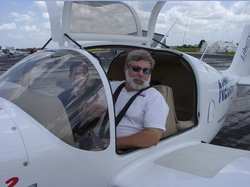 Overall; the XL-2 is living up to the hype that is
building over this new entry in the two seat GA sweepstakes.
The bird emphasizes a playful but overtly obedient personality with
excellent stability, great performance and truly outstanding
economics. While a good bit of my background is filled with flying
various rocketships willy-nilly through the ether, I have to admit
that I both appreciated and enjoyed the feel of this simple little
side-by-sider. It, simply put, was a lot of fun to fly. Liberty has
a hell of a good little airplane on its hands, and I really look
forward to flying a production bird later this year. Highly
recommended.
Overall; the XL-2 is living up to the hype that is
building over this new entry in the two seat GA sweepstakes.
The bird emphasizes a playful but overtly obedient personality with
excellent stability, great performance and truly outstanding
economics. While a good bit of my background is filled with flying
various rocketships willy-nilly through the ether, I have to admit
that I both appreciated and enjoyed the feel of this simple little
side-by-sider. It, simply put, was a lot of fun to fly. Liberty has
a hell of a good little airplane on its hands, and I really look
forward to flying a production bird later this year. Highly
recommended.
 ANN's Daily Aero-Term (12.19.25): Ultrahigh Frequency (UHF)
ANN's Daily Aero-Term (12.19.25): Ultrahigh Frequency (UHF) NTSB Prelim: Cirrus Design Corp SR22T
NTSB Prelim: Cirrus Design Corp SR22T Classic Aero-TV: The Red Tail Project--Carrying the Torch of the Tuskegee Airmen
Classic Aero-TV: The Red Tail Project--Carrying the Torch of the Tuskegee Airmen Aero-News: Quote of the Day (12.19.25)
Aero-News: Quote of the Day (12.19.25) Airborne 12.17.25: Skydiver Hooks Tail, Cooper Rotax Mount, NTSB v NDAA
Airborne 12.17.25: Skydiver Hooks Tail, Cooper Rotax Mount, NTSB v NDAA























